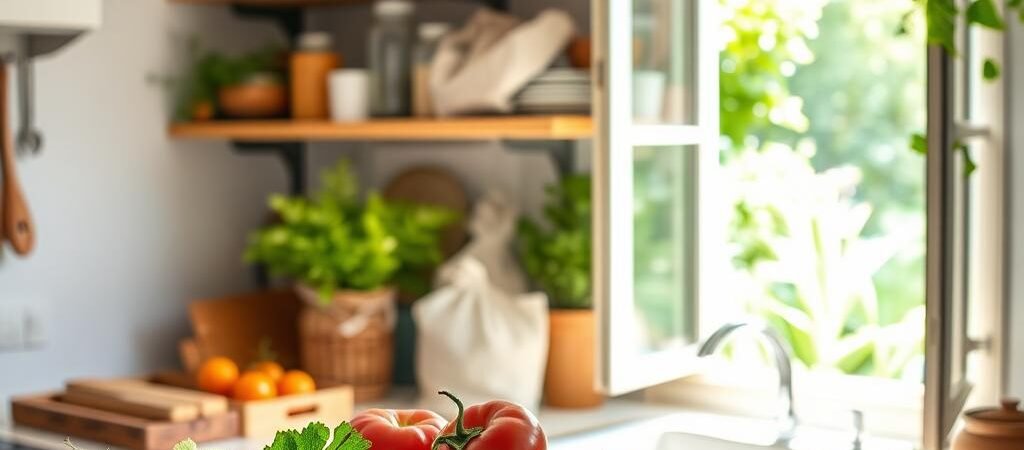Did you know the average American generates 4.9 pounds of waste every day? That’s a staggering amount, and it’s contributing to a global crisis. By 2050, the UN predicts worldwide waste could triple to 3.8 billion tons. But here’s the good news: small changes in your daily lifestyle can make a big impact.
Adopting a zero-waste mindset doesn’t mean perfection. It’s about progress. Simple swaps, like choosing a reusable coffee mug or supporting programs like Patagonia’s Worn Wear, can add up. These small habits not only reduce waste but also bring mental clarity and purpose to your day.
Together, we can create a cleaner, healthier world. Ready to take the first step? Let’s explore seven core habits that make a difference.
What Does Zero-Waste Really Mean?
The concept of zero-waste is more than just a trend—it’s a movement reshaping our relationship with the planet. According to the EPA, only 32.1% of U.S. waste is recycled or composted. The rest ends up in landfills, where it contributes to methane emissions and pollution. This is where zero-waste steps in, offering a solution to reduce our impact on the environment.
Understanding the Zero-Waste Philosophy
Zero-waste isn’t about eliminating all waste overnight. It’s about making smarter choices in your daily lifestyle. For example, the average American throws away nearly one pound of food daily, which releases methane—a potent greenhouse gas. By reducing food waste, you can make a significant difference.
The CDC reports that 70% of industrial waste is dumped into waterways globally. This pollution affects ecosystems and human health. By adopting zero-waste habits, you can help reduce this impact and protect our environment.
Why Zero-Waste Matters in Everyday Life
Every small action counts. Did you know 500 billion disposable coffee cups are used yearly? Switching to a reusable cup is a simple yet powerful step. Companies like United by Blue are leading the way by removing one pound of trash from oceans for every product sold.
The circular economy is another key concept. It focuses on reusing and recycling materials to minimize waste. This approach not only benefits the environment but also creates green jobs—1.5 million by 2030, according to projections.
Reducing consumption can also improve mental wellbeing. When you focus on what you truly need, you feel more purposeful and less overwhelmed. Zero-waste is about progress, not perfection. Start small, and you’ll see how your actions ripple out to create a better world.
Start Small: Why You Can’t Go Zero-Waste Overnight
Going zero-waste is a journey, not a race—take it step by step. The average American generates 4.4 pounds of waste daily, with one pound being food waste. Trying to eliminate all of this at once can feel overwhelming. Instead, focus on gradual changes that fit into your life.
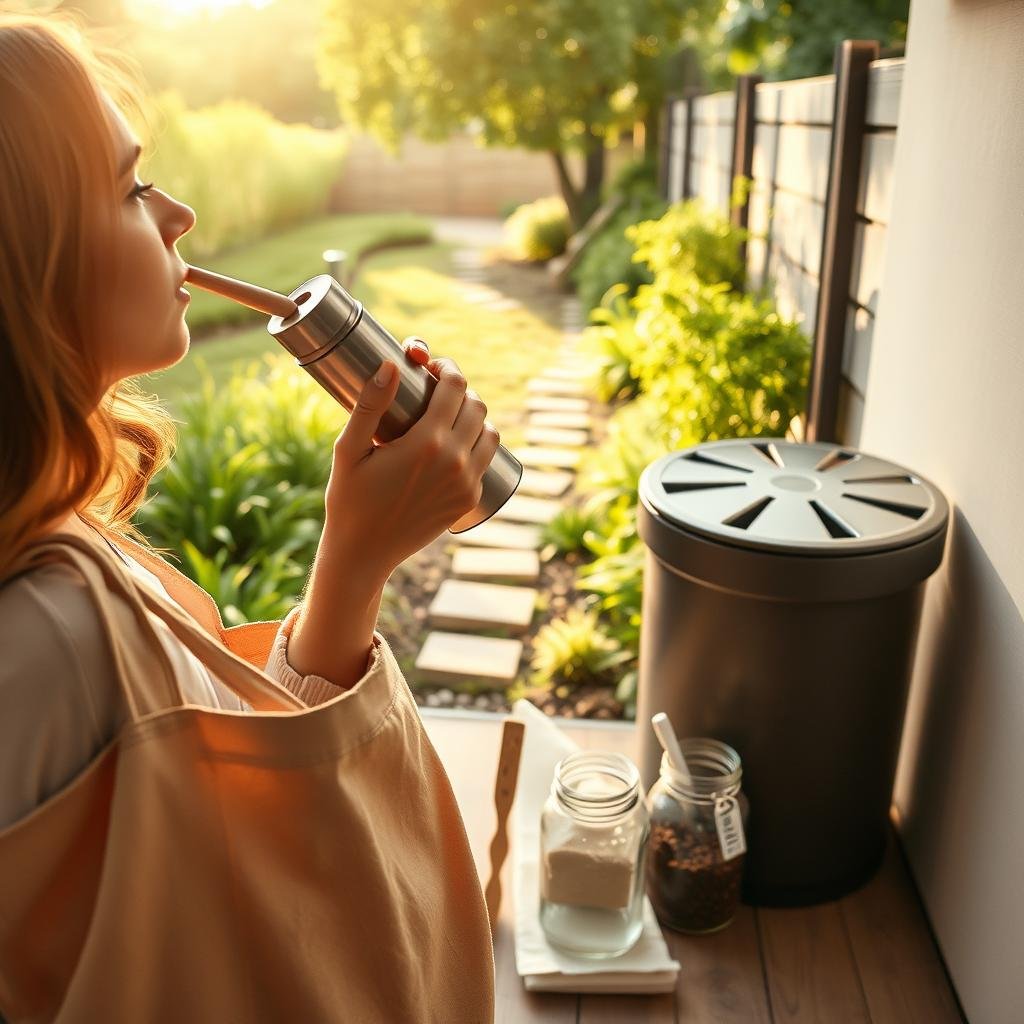
Start by adopting the 5 Rs: Refuse, Reduce, Reuse, Recycle, and Rot. This hierarchy helps prioritize actions that have the most impact. For example, refuse single-use plastics or reduce food waste by planning meals ahead of time.
The Importance of Gradual Change
Small, consistent steps are more sustainable than drastic shifts. Begin with one change per week, like switching to a shampoo bar instead of bottled shampoo. Tools like the iWARM energy savings calculator can show how these swaps reduce your carbon footprint.
Analysis paralysis is common when starting. Instead of overthinking, focus on one habit at a time. Try the 14-day food waste challenge to see how small adjustments can lead to big results.
Setting Realistic Expectations
Zero-waste isn’t about perfection—it’s about progress. Habit-stacking, or pairing new habits with existing ones, can make the transition easier. For instance, bring reusable bags every time you shop.
Over time, these small changes add up. They not only reduce waste but also save money and improve mental clarity. Remember, every step counts toward a cleaner, healthier way of living.
Drink More Water, But Skip the Bottles
Staying hydrated is essential, but single-use plastic bottles are wreaking havoc on the environment. Every year, 17.6 billion pounds of plastic enter our oceans, polluting ecosystems and harming marine life. A single bottle takes over 450 years to decompose, leaving a lasting impact on the planet.
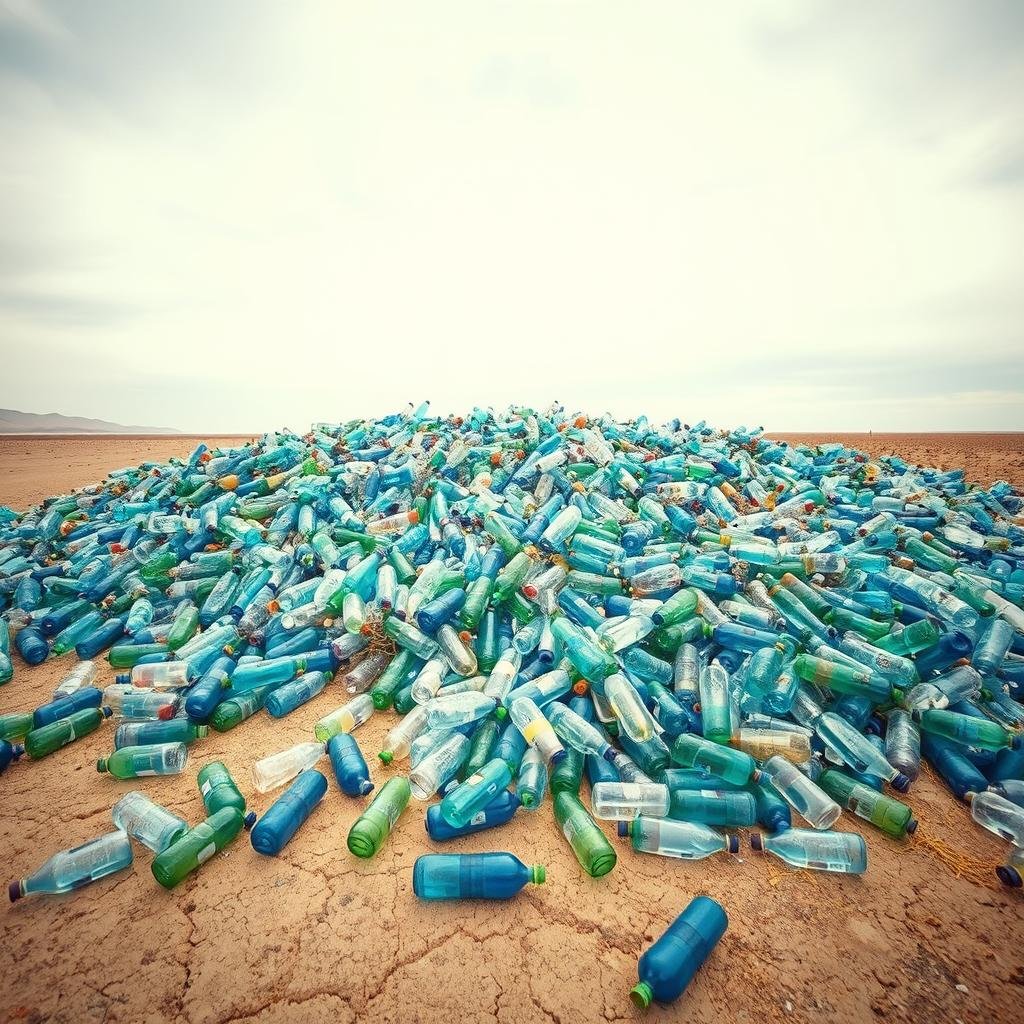
The Environmental Impact of Bottled Water
Bottled water might seem convenient, but its cost goes beyond your wallet. The production and disposal of plastic bottles contribute to massive waste and pollution. The Great Pacific Garbage Patch, a floating mass of trash twice the size of Texas, is a stark reminder of this crisis.
Tap water, on the other hand, is far more sustainable. It’s also cheaper—switching can save you hundreds of dollars annually. If you’re concerned about quality, invest in a filtered pitcher or check your local water quality report for peace of mind.
How to Transition to Tap Water
Making the switch is easier than you think. Start by investing in a reusable bottle made of stainless steel or glass. Brands like Yeti Tumblers are durable and eco-friendly, making them a lifetime investment.
If you miss the flavor of bottled water, try infusing tap water with fruits or herbs. It’s a refreshing and waste-free alternative. For those in areas with poor water quality, filtered pitchers or under-sink systems are excellent solutions.
Every small step counts. By ditching plastic bottles, you’re not just saving money—you’re protecting the planet for future generations.
Swap Plastic Produce Bags for Reusable Alternatives
Every trip to the store can be a step toward sustainability. Did you know 500 billion plastic bags are used yearly? These single-use items end up in landfills and oceans, harming ecosystems. Switching to reusable produce bags is a simple yet powerful way to reduce waste.
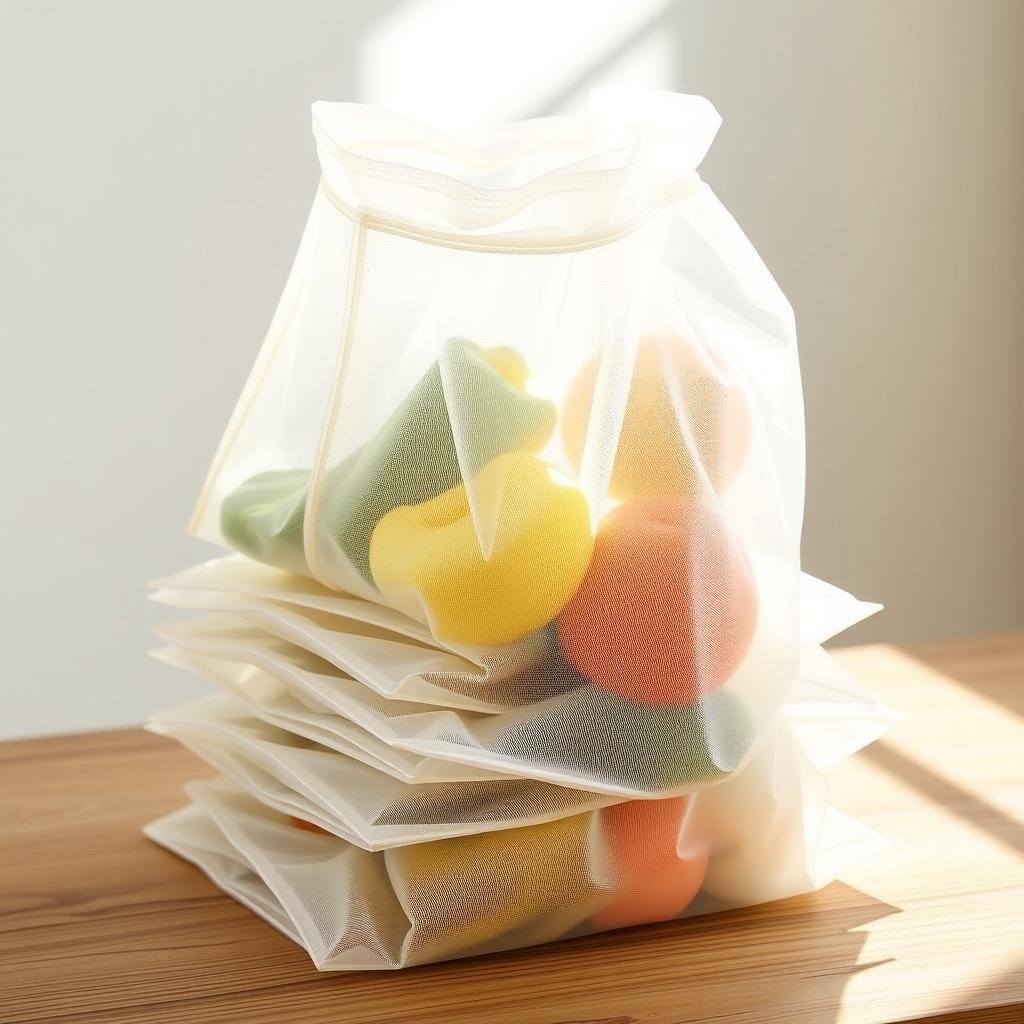
Why Cloth Produce Bags Are a Game-Changer
Cloth and mesh bags are durable, washable, and eco-friendly. Unlike plastic, they don’t tear easily and can last for years. They’re perfect for carrying fruits, veggies, or bulk items during your shopping trips.
Some markets, like Sunnyvale Farmers’ Market, even offer free reusable bags to encourage sustainable shopping. By making this switch, you’re not just reducing waste—you’re setting an example for others.
Where to Find or Make Your Own Produce Bags
You don’t need to spend a fortune on reusable produce bags. Many stores sell affordable options, or you can make your own. Upcycle old sheets or t-shirts into simple drawstring bags. It’s a fun DIY project that gives new life to unused fabrics.
For bulk purchases, look for bags with weight-tare markings. This ensures you’re only paying for the product, not the bag. Keep a few in your car or purse so you’re always prepared for a trip to the store.
Small changes like this can transform your way of living. Start today, and see how easy it is to make a difference.
Use What You Already Have Before Buying New
Before rushing to the store, take a moment to see what’s already in your home. Many items can be repurposed or reused, saving you money and reducing waste. Did you know 90% of products are replaced unnecessarily? Start by exploring what you already own.
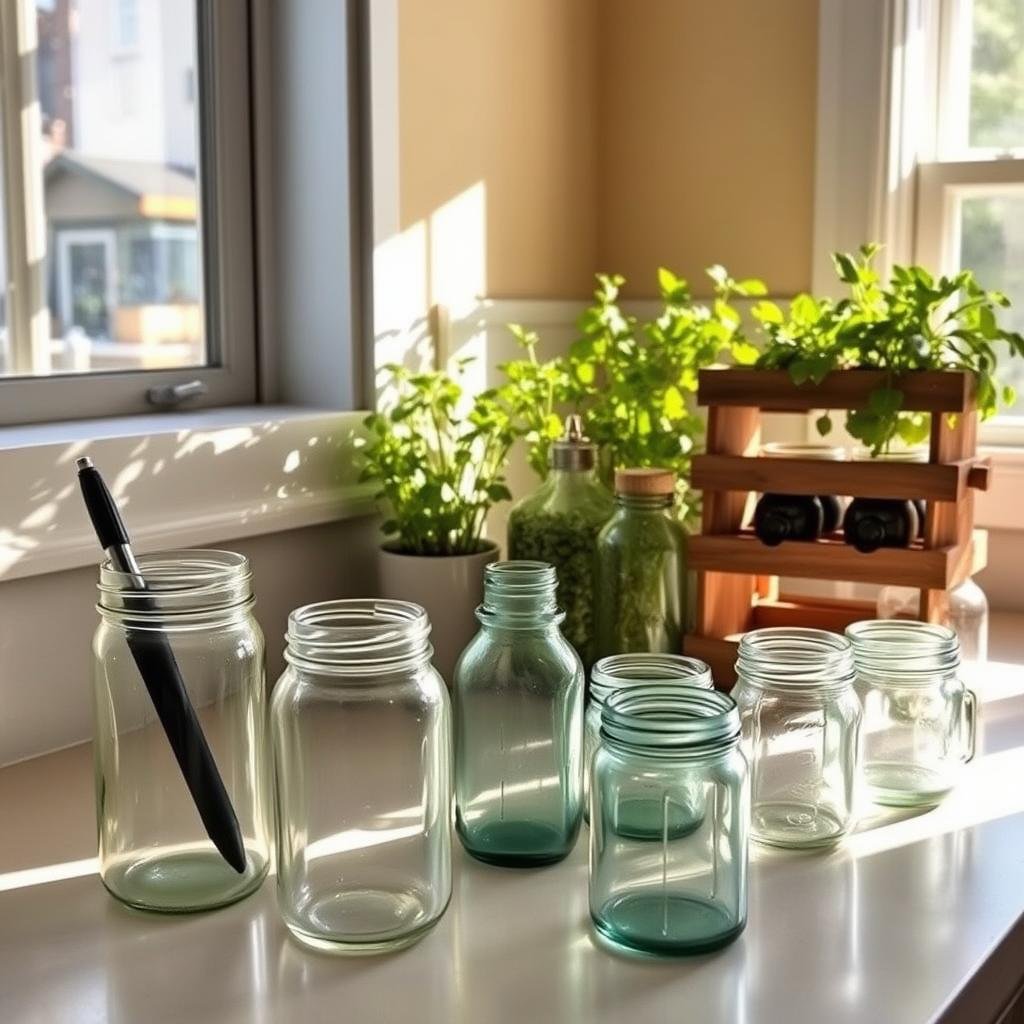
The Power of Repurposing Jars and Containers
Glass jars and containers are versatile and eco-friendly. Use them to organize your pantry, bathroom, or workspace. Label them with chalk paint for a clean, cohesive look. Thrift stores are also great places to find unique containers for your needs.
Restaurants often discard perfectly good glass jars. Ask if you can take a few home for your projects. This simple act not only reduces waste but also gives these items a second life.
How to Avoid Unnecessary Purchases
Impulse buying can lead to clutter and waste. Before making a purchase, ask yourself if you truly need the product. Implement a 30-day waiting period to curb emotional spending. This habit helps you focus on what’s essential.
Join Buy Nothing groups in your community. These groups encourage sharing and reusing items, reducing the need for new shopping. Repairing broken products instead of replacing them can also save resources and money.
- Create a zero-waste kit using items you already own.
- Compare repair costs versus buying new.
- Highlight REI Garage Sale finds for affordable gear.
Small changes like these can transform your shopping habits. Start today and see how much you can achieve with what you already have.
Reduce Food Waste with Simple Strategies
Food waste is a major issue, but small changes can make a big difference. The average American throws away nearly 1 pound of food daily, contributing to methane emissions in landfills. By adopting smarter habits, you can save money and protect the environment.
Meal Planning and Inventory Checks
Start by planning your meals for the week. This helps you buy only what you need and reduces impulse purchases. Create an “Eat Me First” section in your fridge for items nearing expiration. It’s a simple way to prioritize food before it goes bad.
Regular inventory checks are also key. Before grocery shopping, take stock of what you already have. Apps like Olio can help you share excess food with neighbors, reducing waste and building community.
Creative Ways to Use Leftovers
Leftovers don’t have to be boring. Turn last night’s roasted veggies into a hearty lunch salad or blend them into a soup. Chickpeas from dinner? Use them for a quick hummus or a protein-packed wrap.
Here are 10 creative ideas to repurpose leftovers:
- Transform rice into fried rice with veggies and soy sauce.
- Blend overripe fruit into smoothies or baked goods.
- Use stale bread for croutons or bread pudding.
- Turn roasted chicken into a savory pot pie.
- Make a frittata with leftover veggies and eggs.
- Blend cooked beans into a dip or spread.
- Create a grain bowl with leftover grains and proteins.
- Use pasta in a cold salad with fresh veggies.
- Turn mashed potatoes into potato pancakes.
- Freeze extra soup for a quick meal later.
Composting is another powerful tool. Set up a compost bin for fruit peels, coffee grounds, and other organic waste. It reduces methane emissions and creates nutrient-rich soil for your garden.
By making these changes, you’ll not only reduce waste but also save hundreds of dollars each year. Start today and see how easy it is to make a difference!
Cook More Meals at Home to Cut Down on Packaging
Cooking at home isn’t just about saving money—it’s a powerful way to reduce waste. Takeout packaging accounts for 45% of urban litter, and it’s often non-recyclable. By preparing meals in your home, you can significantly cut down on this environmental burden.
Bulk cooking saves an average of 3 hours weekly, giving you more time for the things you love. Plus, it’s a chance to get creative with products you already have in your pantry.
The Benefits of Home-Cooked Meals
Home-cooked meals are healthier, more affordable, and eco-friendly. You control the ingredients, avoiding unnecessary packaging and preservatives. Reusable containers make storing leftovers easy, reducing waste even further.
Many local chains now support reusable container policies. Bring your own containers when dining out to minimize single-use waste. It’s a small change with a big impact.
Tips for Quick and Easy Meal Prep
Batch cooking is a game-changer. Spend a few hours on the weekend preparing meals for the week. Use glass containers for storage—they’re durable and microwave-safe.
Here are some ideas to get started:
- Try 15-minute pantry meals for busy weeknights.
- Invest in essential tools like a pressure cooker or silicone wraps.
- Assemble jar salads for grab-and-go lunches.
- Explore “no recipe” cooking for stress-free meals.
By cooking at home, you’ll save money, reduce waste, and enjoy healthier meals. Start small, and you’ll see how these habits transform your life.
Switch to Bar Soap and Shampoo Bars
Making the switch to bar soap and shampoo bars can transform your daily routine. These products are not only eco-friendly but also cost-effective and convenient. By ditching liquid soap and shampoo, you can significantly reduce plastic waste and make a positive impact on the environment.
Why Bars Are Better Than Bottles
Liquid soap requires five times more packaging than bar soap, contributing to unnecessary waste. Bar soap and shampoo bars, on the other hand, often come with minimal or no packaging. Brands like Ethique offer bars that last up to 80 washes, making them a sustainable choice.
Here are some benefits of switching to bars:
- Lower cost compared to liquid products.
- Reduced plastic waste from bottles.
- Compact and travel-friendly options.
Finding the Right Products for You
Choosing the right bar soap or shampoo bar depends on your needs. For sensitive skin, look for sulfate-free products like those from Lush or J.R. Liggett’s. If you’re new to bars, try sampling programs to find your perfect match.
Proper storage is key to extending their lifespan. Use a soap dish or travel-friendly tin to keep them dry and long-lasting. For a natural hair routine, consider baking soda and vinegar as alternatives to traditional shampoo.
Visit package-free stores or online shops to explore your options. This simple switch is a way to reduce waste and embrace a more sustainable lifestyle.
Shop at Farmers’ Markets for Less Plastic Packaging
Shopping at farmers’ markets is a win-win for you and the planet. These local hubs offer fresh, seasonal produce with minimal plastic and packaging. Plus, you’re supporting your community’s economy while reducing your environmental footprint.
How Farmers’ Markets Reduce Waste
Farmers’ markets are a sustainable alternative to traditional stores. Unlike supermarkets, vendors often use minimal packaging. Many encourage you to bring your own bags or containers, cutting down on single-use plastic.
Here are some ways to make your market trips even greener:
- Bring reusable bags and containers for your purchases.
- Shop for seasonal produce to reduce transportation emissions.
- Ask vendors about their packaging policies and suggest eco-friendly options.
Supporting Local Economies While Going Green
When you shop at farmers’ markets, your money stays in the community. Farmers keep 90 cents of every dollar, compared to just 17 cents in traditional stores. This boosts the local economy and helps small businesses thrive.
Here’s how you can maximize your impact:
- Build relationships with vendors for insider tips and discounts.
- Explore ugly produce options, which are often sold at a discount.
- Use payment options like SNAP to make fresh food accessible to everyone.
By choosing farmers’ markets, you’re not just shopping—you’re making a difference. Start today and see how easy it is to support sustainability and your community.
Embrace Imperfection: Progress Over Perfection
Progress, not perfection, is the key to a sustainable lifestyle. The journey to zero waste isn’t about doing everything right—it’s about making consistent, meaningful changes. Every small step you take adds up to a bigger impact on the world.
Did you know 50 million tons of clothing end up in U.S. landfills yearly? Or that using one reusable cup can save 365 disposable ones? These numbers show how small habits can create a ripple effect. Celebrate every win, no matter how small.
Why Small Changes Still Matter
Small changes are the foundation of lasting transformation. Switching to a reusable water bottle or composting food scraps might seem minor, but they add up over time. These actions reduce waste and inspire others to follow your lead.
Consider tracking your progress with habit-tracking apps like Habitica or Streaks. They help you stay accountable and motivated. A 30-day challenge, like Plastic-Free July, can also kickstart your journey. Every step counts toward a cleaner, healthier way of living.
Celebrating Every Step Toward Zero-Waste
Overcoming social pressure can be tough, but staying true to your goals is worth it. Share your journey with friends or join community support groups. They provide encouragement and practical tips for staying on track.
Conducting a waste audit is another powerful tool. It helps you identify areas for improvement and celebrate overlooked wins. Remember, setbacks are learning opportunities, not failures. Keep moving forward, one step at a time.
By embracing imperfection, you’re not just reducing waste—you’re creating a better life for yourself and the planet. Start today and see how far you can go!
Your Zero-Waste Journey Starts Here
Your journey to a sustainable lifestyle begins with small, actionable steps. By adopting these habits, you’re not just reducing waste—you’re creating a better way of living. Every choice you make today shapes a healthier world for tomorrow.
Start with the 14-day food waste challenge, which reduces waste by 40% on average. Track your progress with a downloadable checklist or habit-tracking apps. Share your wins with a buddy system for added motivation.
Explore local recycling guides and monthly habit reviews to stay on track. Celebrate every step, no matter how small. Together, we can make a difference—one day at a time.
Ready to take the first step? Begin today and see how far you can go!
